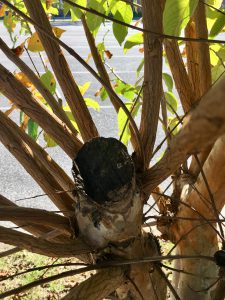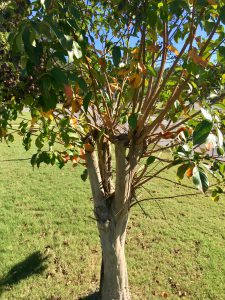Too often people hack away at crape myrtle trees and “butcher” them. The term “crape murder” was coined to describe this drastic topping of crape myrtles.
Properly selected and properly placed crape myrtles need little pruning. A crape myrtle that requires routine pruning to force it to fit into a smaller space should be considered for
replacement with a smaller-maturing cultivar. The real problem here is that you have the wrong plant in the wrong place. The person that planted the tree did not do their homework. To avoid having to annually “butcher” a nice tree, choose a smaller maturing crape myrtle.
After topping, the tree will insist on growing to its genetically designed size, again and again.
If you want a crape myrtle that will naturally stay below four feet in height, buy a dwarf cultivar such as Pocomoke. There are semi-dwarf cultivars that grow to about twelve feet or less in height such as Acoma. There are intermediate crape myrtles that top out at less than twenty feet in height such as Osage. And there are crape myrtles that grow greater than twenty feet in height such as the popular Natchez cultivar. Choose the right size plant to fit the selected space.
Topping trees is a bad practice. It weakens a tree by removing food reserves that were stored in the now removed wood. It also radically reduces the size of the canopy decreasing the plant’s ability to produce food
through photosynthesis. The large open cuts caused from topping invite wood-rotting organisms and ultimately decay. Topping results in many dead stubs throughout the tree. Topping a crape myrtle forces the tree to produce many unsightly root suckers. Ultimately, topping results in an ugly, odd-looking, higher maintenance and short-lived crape myrtle.

Note open wound, decay and weak attachment of multiple shoots as a result of improper pruning. Photo credit: Larry Williams
Many people believe crape myrtles have to be cut way back in order to produce an abundance of blooms. Flower clusters may be slightly larger on topped trees. But topping usually delays flowering up to one month and since the tree is smaller, it produces fewer flowers. The long, weak shoots supporting the large, heavy flower clusters on topped crape myrtles bend awkwardly and are more likely to break away from the plant.
When pruning crape myrtle trees, avoid cutting back or shortening branches much larger than your finger, although cutting larger branches back to a side branch or to the trunk when needed is fine.
More information on crape myrtle selection and care is available at the below links.
http://edis.ifas.ufl.edu/mg266, http://edis.ifas.ufl.edu/ep399
- Evaluate and Renovate Landscape During Fall - October 30, 2025
- Summer is Too Hot for Lawn Herbicides - August 23, 2025
- Nuisance Gnats abound in Northwest Florida this spring - June 26, 2025


